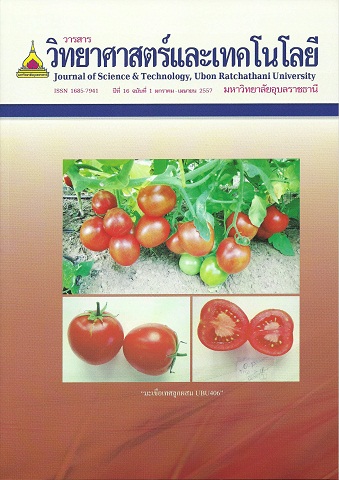ผลของถ่านชีวภาพจากไม้ไผ่ และแกลบต่อผลผลิต และประสิทธิภาพการดูดใช้ไนโตรเจน ของข้าวพันธุ์ชัยนาท 1
Main Article Content
บทคัดย่อ
การใส่ถ่านชีวภาพลงในดินเป็นเทคโนโลยีหนึ่งที่ได้รับความสนใจเพื่อปรับปรุงดินในนาข้าว การศึกษาครั้งนี้มีวัตถุประสงค์เพื่อศึกษาผลของการใส่ถ่านต่อการเจริญเติบโต และประสิทธิภาพการใช้ปุ๋ยไนโตรเจนของข้าว รวมทั้งผลต่อคุณสมบัติทางเคมีของดิน โดยปลูกข้าวพันธุ์ ชัยนาท 1 ในเรือนทดลอง กรรมวิธีในการทดลองประกอบด้วย 4 กรรมวิธี ดังนี้ 1) ดินอย่างเดียว, 2) ปุ๋ยเคมี, 3) ถ่านไม้ไผ่ และ4) ถ่านแกลบ จากการศึกษาพบว่า ถ่านไม้ไผ่มีค่า pH สูงกว่าถ่านแกลบแต่ค่า CEC ต่ำกว่าถ่านแกลบ เนื่องจากถูกเผาด้วยอุณหภูมิที่แตกต่างกัน ข้าวเมื่ออายุ 30 วันหลังปักดา พบว่า ถ่านแกลบให้น้ำหนักแห้งของข้าวสูงกว่าการใส่ปุ๋ยเคมี (P<0.01) เมื่ออายุ 60 วันหลังปักดา กรรมวิธีที่ใส่ปุ๋ยเคมีมีความสูง จำนวนหน่อต่อกอ และน้ำหนักแห้งของข้าวสูงกว่าการใส่ถ่านไม้ไผ่ และถ่านแกลบ ดังนั้นการใส่ปุ๋ยเคมีในนาข้าวจะถูกใช้ช่วงหลังจาก 30 วันหลังปักดา เมื่อระยะเก็บเกี่ยว พบว่า กรรมวิธีที่ใส่ปุ๋ยเคมีมีน้ำหนักแห้งต้นข้าว และน้ำหนักแห้งทั้งหมดสูงสุด แต่ไม่มีความแตกต่างของผลผลิตข้าวในระหว่างกรรมวิธี อย่างไรก็ตาม ค่า HI และ NUE ในกรรมวิธีการใส่ถ่านไม้ไผ่ และถ่านแกลบ สูงกว่ากรรมวิธีที่ใส่ปุ๋ยเคมี (P<0.01) จากผลการศึกษานี้มีแนวโน้มให้เห็นว่า การใส่ถ่านชีวภาพร่วมกับปุ๋ยเคมีที่เหมาะสมจะทำให้เพิ่มประสิทธิภาพการใช้ปุ๋ยไนโตรเจน และผลผลิตข้าวได้ดีกว่าการใส่ปุ๋ยเคมีในนาข้าวเพียงอย่างเดียว
Effects of Bamboo and Rice Husk Biochars on Yield and Nitrogen use Efficiency of Chainat 1 Rice Variety
Biochar application on the soil is a technology that is of interest for the improvement of paddy soil. The objective of this study was to investigate the effects of biochar on the yield and nitrogen use efficiency of the rice variety Chainat 1 grown in a greenhouse experiment. The experiment consisted of 4 treatments: 1) soil alone, 2) chemical fertilizer, 3) bamboo biochar, and 4) rice husk biochar. This study found that the soil treated with bamboo biochar had a higher pH value but a lower cation exchange capacity than that of rice husk biochar due to different pyrolysis temperature. At 30 days after transplanting, rice husk biochar treatment resulted in higher shoot dry weight than the chemical fertilizer treatment (P<0.01). At 60 days after transplanting, chemical fertilizer treatment results were higher in height, tiller number, and shoot dry weight than bamboo and rice husk biochar treatments. This showed the rice uptake of chemical fertilizer after 30 days after transplanting. At final harvest, shoot dry weight and total dry weight as a result of the chemical fertilizer treatment were significantly higher than the bamboo and rice husk biochar treatments (P<0.01). There were no significant differences in the grain yield between the treatments. In addition, it was found that the harvest index and nitrogen use efficiency values in bamboo and rice husk biochar treatments were higher than the chemical fertilizer treatment (P<0.01). The results of this study indicated that the application of biochar with suitable chemical fertilizer increased the nitrogen use efficiency and rice yield more than chemical application alone.
Article Details
บทความที่ได้รับการตีพิมพ์เป็นลิขสิทธิ์ของ วารสารวิทยาศาสตร์และเทคโนโลยี มหาวิทยาลัยอุบลราชธานี
ข้อความที่ปรากฏในบทความแต่ละเรื่องในวารสารวิชาการเล่มนี้เป็นความคิดเห็นส่วนตัวของผู้เขียนแต่ละท่านไม่เกี่ยวข้องกับมหาวิทยาลัยอุบลราชธานี และคณาจารย์ท่านอื่นๆในมหาวิทยาลัยฯ แต่อย่างใด ความรับผิดชอบองค์ประกอบทั้งหมดของบทความแต่ละเรื่องเป็นของผู้เขียนแต่ละท่าน หากมีความผิดพลาดใดๆ ผู้เขียนแต่ละท่านจะรับผิดชอบบทความของตนเองแต่ผู้เดียว


